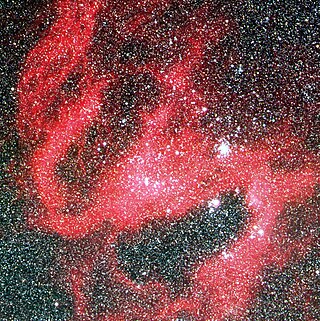LHA-120 N119
| Emission nebula | |
|---|---|
| H II region | |

|
|
| Observation data: J2000.0 epoch | |
| Subtype | Emission nebula |
| Right ascension | 5h 18m 45s |
| Declination | −69° 14′ 03″ |
| Distance | 160,000 ly (50,000 pc) |
| Apparent magnitude (V) | 5.60 |
| Apparent dimensions (V) | 9′ 14″ × 12′ 15″ |
| Constellation | Dorado |
| Physical characteristics | |
| Absolute magnitude (V) | −13 (1040.7 erg/s) |
| Dimensions | 131 × 175 pc (430 × 570 ly) |
| Notable features | Unusual shape |
| Designations | N119, DEM L132, PKS 0518-692, LHA 120-N119 |
N119 (formally known as LHA 120-N119) is a spiral-shaped HII region in the Large Magellanic Cloud. Its dimensions are large, at 131 x 175 pc (430 × 570 ly). It contains several luminous stars including S Doradus, LH41-1042, and LMC195-1. Its peculiar S-shaped structure is difficult to explain with classical models.
With a right ascension of 5h 18m 45s and a declination of −69° 14′ 03″, this nebula may be found in the constellation of Dorado about 160 kly (50 kpc) away. Its apparent size is 9′ 14.34″ × 12′ 14.82″. It lies projected against the LMC's stellar bar (the LMC was a barred spiral galaxy until it got too close to the Milky Way), 15′ southeast of its center of rotation.
The nebula seems to be in an S-shape, but on closer inspection reveals to have extensions of the spiral arms, ending in a figure 8. The unusual shape may be due to the combination of other nebula, or it may have been formed by perforation of the original molecular cloud by powerful stellar winds and explosions.
It may have also formed by a collision of two interstellar clouds, according to Annie Laval and Patricia Ambrocio-Cruz. The gas would have been compressed, forming the luminous stars seen today.
N119 contains several bubble-shaped nebulae: DEM L132a; DEM L132b; DEM L123; and an unnamed WR nebula. In total the nebulosity of N119 spans 131 by 175 parsecs (430 ly × 570 ly).
DEM L132a is 88 parsecs across and encompasses the two luminous blue variables S Doradus and R85. However, those stars do not emit sufficient ionising radiation to produce the observed shell, and no other hot luminous stars are seen within the shell. It may have been produced by one or both of the LBVs during an earlier phase of their evolution. DEM L132b is 52 parsecs wide and surrounds two class O giants or supergiants and numerous other hot stars, which comfortably produce the necessary ionising radiation and fast winds to sculpt the bubble from the surrounding interstellar material. The WR bubble nebula is a similar size to DEM L132b and is produced by Brey 21, a binary containing a WN3 star and a B-type supergiant. DEM L123 is 158 parsecs across and its origins are unclear. No sufficiently powerful stars have been detected inside it that could produce it with their stellar wind (as this would require the power of 44 O6 supergiants) and it is ten times too energetic to have originated from a typical supernova. This bubble may have been created by a hypernova.
...
Wikipedia
